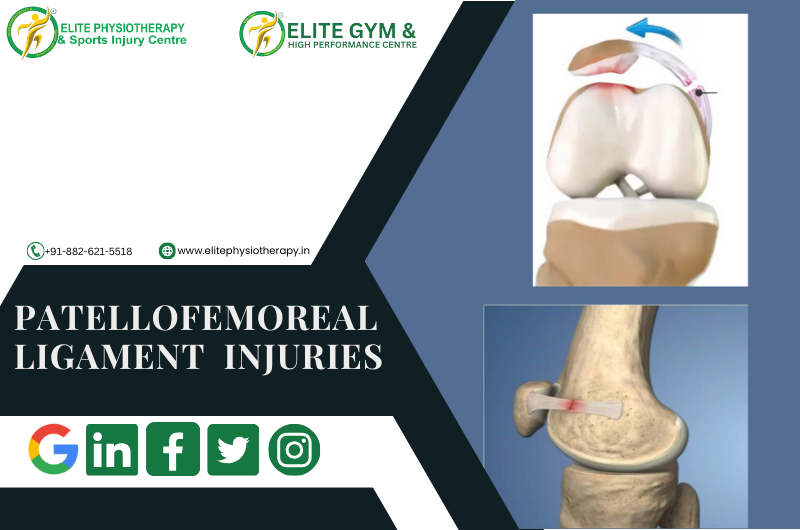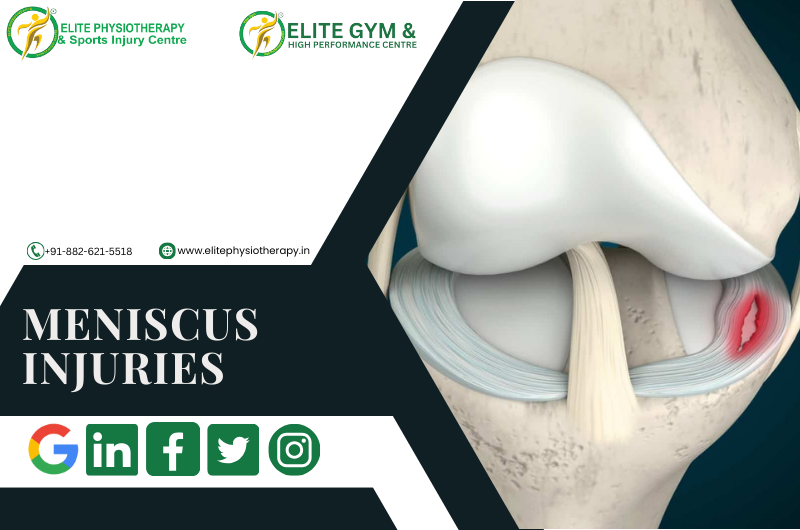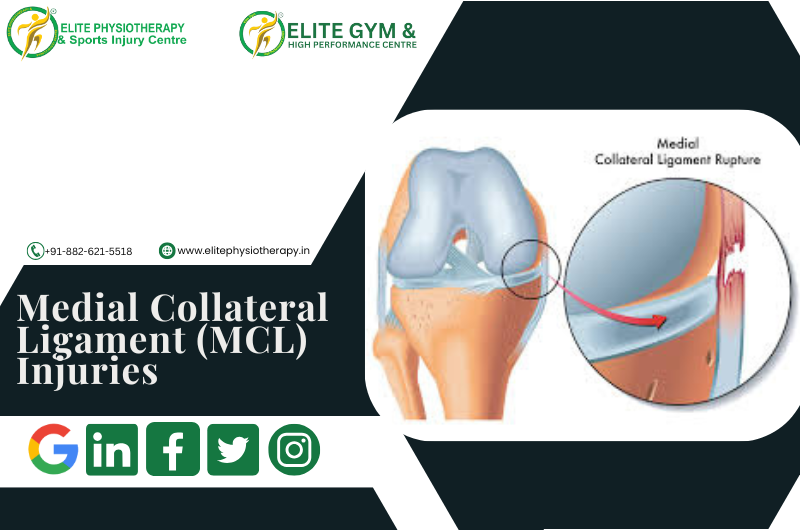Sports and other high-impact activities frequently result in patellofemoral ligament injuries, especially those involving the Medial Patellofemoral Ligament (MPFL) and Lateral Patellofemoral Ligament (LPFL). These ligaments are essential for keeping the patella (kneecap) stable when moving. Pain, decreased functionality, and patellar instability can result from injuries to these ligaments. At Elite Physiotherapy & Sports Injury Centre, we specialize in diagnosing and managing such injuries using cutting-edge technology and personalized care.
Understanding MPFL and LPFL
MPFL: The MPFL is the main stabilizer that keeps the patella from moving laterally. During patellar subluxations or dislocations, it frequently sustains injury.
LPFL: Although less frequently injured, the LPFL is essential for preserving medial patellar alignment.
Injuries, overuse, or anatomical predispositions such as muscle imbalances or malalignment can all cause injuries to these ligaments.
Causes and Mechanism of Injury
Causes
Trauma: Sudden twisting motions or direct impact to the knee.
Overuse: Constant tension brought on by exercises like jumping or running.
Anatomical factors: include a shallow trochlear groove, weak quadriceps, or patella malalignment.
Previous Dislocations: increased susceptibility following an initial injury.
Mechanism of Injury
MPFL Injuries: MPFL injuries are frequently brought on by lateral patella dislocation, which is frequently brought on by valgus force in conjunction with external knee rotation.
Example: A soccer player makes a sudden turn to avoid an opponent during a game. The patella dislocates laterally as a result of the planted leg undergoing an external rotation and the knee experiencing valgus stress. The MPFL, the main barrier preventing lateral patellar movement, is strained or torn by this force. Immediate pain, swelling, and an incapacity to play are experienced by the player.
This illustration demonstrates a typical on-field mechanism of injury including sudden direction changes, which are characteristic of sports like volleyball, basketball, and soccer.
LPFL Injuries: Injuries to the Lateral Patellofemoral Ligament (LPFL) are less common than those of the MPFL but can significantly affect knee stability and function. High-energy trauma or specific sports-related incidents that displace the patella medially often cause LPFL injuries.
Example: A valgus force is applied when a weightlifter’s knees fold inward during a heavy barbell squat because of poor form or muscle fatigue. The LPFL is strained or torn concurrently with an excessive medial pull on the patella brought on by hyperactive quadriceps or inadequate gluteal activation. The athlete has trouble bearing weight and immediately feels pain on the lateral side of the knee.
This illustration demonstrates that improper technique or muscular imbalances when lifting weights can cause LPFL injuries.
Signs and Symptoms
Pain: Located near the patella, frequently made worse by stair climbing and squatting.
Swelling: Acute swelling brought on by harm to soft tissues.
Instability: The sensation that the knee is “giving way,” particularly when moving laterally.
Reduced Range of Motion (ROM): Inability to bend or extend.
Tenderness: Palpating the MPFL or LPFL regions reveals noticeable tenderness.
Patellar maltracking: Patellar maltracking refers to a visual or tactile deviation during movement.
Diagnosis at Elite Physiotherapy
Clinical and Functional Assessment
Our diagnostic methodology incorporates specialized physiotherapy tests .
Observation: Look for quadriceps atrophy, edema, and patellar malalignment.
Palpation: Determine whether an area is LPFL or MPFL tender.
Special Tests
- Patellar Apprehension Test: A positive patellar apprehension test is indicated when a patient exhibits apprehension during lateral patellar translation, suggesting an MPFL injury.
- Moving Patellar Tracking Test: The Moving Patellar Tracking Test detects abnormalities in the patellar glide.
- Medial Patellofemoral Ligament Stress Test: Our Team evaluates the MPFL’s integrity using the medial patellofemoral ligament stress test.
Physiotherapy Management for Patellofemoral Ligament Injuries
To handle such conditions, Elite Physiotherapy & Sports Injury Centre uses a thorough, individualized approach that incorporates cutting-edge methods and the latest equipment to guarantee the best possible recovery. Here’s a detailed look into the physiotherapy protocol:
1. Initial Assessment and Goal Setting
Detailed Evaluation: Determine the severity of the injury, patellar tracking, and any underlying causes, such as biomechanical problems or muscle imbalances.
Goal Setting: Setting goals that are specific to the requirements of athletes or active people should center on reducing pain, regaining stability, and avoiding recurrence.
2. Pain Management and Early Rehabilitation
Modalities: Methods for reducing pain and inflammation, such as laser therapy, shockwave therapy, and cryotherapy.
Immobilization and Protection: Our Expert Physiotherapist may advise temporary bracing to stabilize the knee.
3. Restoring Mobility and Strength
Range-of-motion (ROM) exercises, including passive and active: Start with controlled motions to protect the injured ligament and avoid stiffness.
- Muscle Strengthening:
- Quadriceps: To improve patellar tracking, concentrate on the Vastus Medialis Oblique (VMO).
- Gluteal muscles: improve stability in the hips.
- Core Strengthening: Strengthening your core will increase your overall functional stability.
4. Proprioception and Neuromuscular Training
Use of balance boards, Proprioceptive exercises, and cutting-edge equipment such as Neuromuscular Electrical Stimulation (NMES) are used to retrain knee stability and coordination.
5. Advanced Functional Training
gradual return to sports-specific motions with the aid of resistance training, hydrotherapy, and Kinesio Taping.
Sport-Specific Drills: A focus on agility training, plyometric activities, and return-to-sport procedures for top athletes.
6. Preventive Strategies and Education
Correct predisposing variables, including incorrect footwear or training mistakes.
self-management skills along with stretching and warm-up activities.
Why Choose Elite Physiotherapy & Sports Injury Centre?
To ensure a quicker recovery and the best possible outcomes, Elite Physiotherapy blends evidence-based procedures with state-of-the-art technologies including Extracorporeal Shockwave Therapy (ECSWT), Cryo-Air Therapy, and High-Intensity Class IV Laser Therapy. The center’s comprehensive rehabilitation strategy helps patients recover from injuries and perform at their best.
For more insights or to book a consultation, visit the Elite Physiotherapy & Sports Injury Centre.










